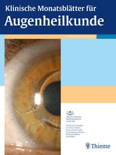
KLINISCHE MONATSBLATTER FUR AUGENHEILKUNDE
Scope & Guideline
Pioneering Research for Visionary Care.
Introduction
Aims and Scopes
- Ophthalmic Disease Management:
The journal covers a wide range of studies on the diagnosis and treatment of various ocular conditions, including glaucoma, age-related macular degeneration, diabetic retinopathy, and other retinal diseases. - Innovative Surgical Techniques:
Research on new surgical methods and their outcomes in ophthalmology is frequently published, showcasing minimally invasive procedures and advancements in techniques such as cataract surgery, keratoplasty, and retinal surgeries. - Artificial Intelligence and Digital Health:
There is a significant focus on the application of artificial intelligence and digital technologies in ophthalmology, including AI for diagnostics, image analysis, and telemedicine solutions. - Pathophysiology and Biomarkers:
The journal explores the underlying mechanisms of ocular diseases and the identification of biomarkers that can aid in diagnosis and treatment, particularly in conditions like glaucoma and retinal disorders. - Patient-Centered Care and Quality of Life:
Studies evaluating patient-reported outcomes, quality of life, and satisfaction with ophthalmic treatments are highlighted, reflecting a growing emphasis on holistic patient care.
Trending and Emerging
- Artificial Intelligence in Ophthalmology:
The use of AI for diagnostic purposes and treatment planning in ophthalmology is rapidly gaining traction, as evidenced by multiple studies exploring its effectiveness in detecting conditions like diabetic retinopathy and glaucoma. - Telemedicine and Remote Patient Monitoring:
The COVID-19 pandemic has accelerated interest in telemedicine, with numerous studies focusing on remote monitoring and virtual consultations as viable alternatives to traditional in-person visits. - Minimally Invasive Surgical Techniques:
There is a growing emphasis on minimally invasive approaches in surgical procedures, particularly in glaucoma and cataract surgeries, reflecting a trend towards reducing patient recovery times and improving outcomes. - Integration of Big Data in Ophthalmology:
Research is increasingly exploring the use of big data analytics to improve patient outcomes and personalize treatment plans, indicating a shift towards data-driven decision-making in clinical practice. - Comorbidity Studies in Ocular Diseases:
Emerging themes include the investigation of systemic diseases' impact on ocular health, particularly in relation to diabetes and hypertension, highlighting the interconnectedness of systemic and ocular health.
Declining or Waning
- Traditional Pharmacological Treatments:
There is a noticeable decline in studies solely focused on traditional pharmacological treatments for ocular diseases, as newer modalities and combination therapies gain prominence. - Basic Science Research:
Research that is purely basic science without clinical implications is becoming less frequent, as the journal shifts towards studies with direct relevance to clinical practice. - Surgical Complications Reporting:
The frequency of publications focusing solely on surgical complications without new insights or management strategies has decreased, suggesting a move towards more comprehensive studies that combine outcomes with improvements in techniques.
Similar Journals
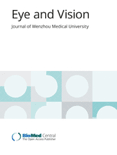
Eye and Vision
Exploring the depths of ocular research and clinical excellence.Eye and Vision, published by BMC, is a leading open-access journal dedicated to the dynamic field of ophthalmology and visual sciences. With its ISSN 2326-0246 and E-ISSN 2326-0254, the journal has established itself as a premier platform for innovative research and clinical studies, achieving impressive rankings in 2023 as Q1 in both Health Professions (Miscellaneous) and Ophthalmology categories. The journal's commitment to accessible knowledge since its transition to open access in 2015 enhances its global reach, allowing researchers, clinicians, and students to share and access top-tier studies and advancements in the field. Located in the United Kingdom and delivering influential insights from 2014 through to 2024, Eye and Vision holds significant relevance, with a Scopus ranking placing it in the 99th percentile for Health Professions and the 93rd percentile for Ophthalmology, making it an essential resource for those looking to stay at the forefront of eye research and vision science.

Nepalese Journal of Ophthalmology
Championing Research for Brighter Futures in Eye HealthNepalese Journal of Ophthalmology, established by the NEPAL OPHTHALMIC SOC, is a premier Open Access journal dedicated to advancing the field of ophthalmology. With its ISSN 2072-6805 and E-ISSN 2091-0320, the journal provides an important platform for sharing innovative research and clinical findings in eye health. Since its inception in 2009, the journal has aimed to disseminate high-quality research that addresses contemporary challenges in ophthalmic practices, thus supporting improved patient care and outcomes within Nepal and beyond. The journal has achieved notable recognition, evidenced by its Scopus rank of #267 out of 915 in the field of General Medicine, placing it within the 70th percentile. Researchers, professionals, and students will find valuable information in its comprehensive articles, which cater to a multidisciplinary audience interested in the latest developments in ophthalmology. Emphasizing accessibility, the journal ensures that all published content is freely available, fostering collaboration and knowledge sharing in the global medical community.

EYE
Illuminating the Frontiers of Vision and Sensory ScienceEYE is a prestigious peer-reviewed journal published by SpringerNature that serves as a cornerstone in the fields of Ophthalmology, Arts and Humanities, and Neuroscience. Since its inception in 1987, this influential journal has consistently maintained a Q1 Quartile ranking across multiple categories, showcasing its commitment to advancing knowledge and research in its disciplines. With a notable impact factor and a robust Scopus ranking—19th in Ophthalmology and 8th in Sensory Systems—EYE is vital for researchers, clinicians, and students alike, providing a platform for groundbreaking studies and critical reviews. While the journal operates under a subscription model, it ensures broad access to high-quality research, facilitating the dissemination of knowledge that shapes the future of eye health and sensory systems. With an address at Campus, 4 Crinan St, London N1 9XW, England, EYE continues to be a leading light in the understanding and advancement of visual health and sensory sciences.
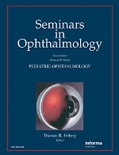
Seminars in Ophthalmology
Pioneering Research for a Brighter VisionSeminars in Ophthalmology is a prestigious journal published by Taylor & Francis Inc, dedicated to advancing knowledge in the field of ophthalmology and related medical areas. Established in 1986, this journal has consistently provided a platform for high-quality research and insights, supporting the community with its impactful publications. With an impressive ranking of #55 out of 137 in the Ophthalmology category, the journal currently holds a Q2 quartile in both ophthalmology and miscellaneous medicine as of 2023, reflecting its significant contribution to the discipline. Researchers and practitioners can access a wealth of information covering a comprehensive range of topics, bolstering both clinical practice and academic inquiry. While not an open-access publication, Seminars in Ophthalmology remains a crucial resource for advancing ophthalmic research, fostering collaboration, and disseminating valuable findings in a rapidly evolving specialty.
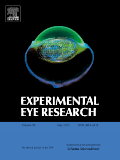
EXPERIMENTAL EYE RESEARCH
Transforming Understanding of Vision Through Rigorous ResearchEXPERIMENTAL EYE RESEARCH, published by Academic Press Ltd - Elsevier Science Ltd, is a preeminent journal dedicated to advancing the fields of ophthalmology and neuroscience. With a history of insightful publications dating back to 1961, this journal serves as a critical platform for researchers, professionals, and students interested in the cellular and molecular mechanisms underlying visual processes. The journal boasts impressive rankings, including being placed in the top quartile (Q1) of both the Ophthalmology and Sensory Systems categories, and is recognized in the 2nd quartile (Q2) for Cellular and Molecular Neuroscience. With an impact factor reflecting its significant contribution to the field, EXPERIMENTAL EYE RESEARCH is a valuable resource that promotes the exchange of innovative research and ideas essential for understanding the complexities of eye function and vision-related disorders. Researchers looking to publish their findings or stay abreast of the latest studies will find this journal a vital component of their academic toolkit.
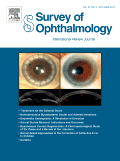
SURVEY OF OPHTHALMOLOGY
Illuminating the Path of Ophthalmic ResearchSURVEY OF OPHTHALMOLOGY is a premier journal published by Elsevier Science Inc, dedicated to advancing knowledge in the field of ophthalmology. With an impact factor reflective of its high-quality research—ranking 7th out of 137 in the Scopus category for medicine and ophthalmology, this journal maintains a prestigious Q1 categorization in its field for 2023. Since its inception in 1956, the journal has provided comprehensive reviews and original articles covering various aspects of ophthalmic research and clinical practice, supporting the ongoing education of researchers, professionals, and students alike. While open access options are not available, the journal remains an essential resource for the latest developments, discoveries, and expert insights that shape the future of eye health. Based in the United States, at STE 800, 230 Park Ave, New York, NY 10169, the journal continues a legacy of excellence in ophthalmology until 2024 and beyond, making it a pivotal element of scholarly discourse in this vital medical discipline.
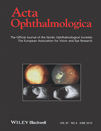
ACTA OPHTHALMOLOGICA
Illuminating the Future of Ophthalmological ResearchACTA OPHTHALMOLOGICA, published by Wiley, is a premier academic journal dedicated to advancing the field of ophthalmology and related medical disciplines. Established in 1923 and maintaining esteemed status through converged years until 1994, and then from 2008 to the present, this journal has consistently delivered pioneering research, reviews, and clinical advancements essential for both practitioners and researchers in eye care. With an impressive impact factor and ranking within the top 15 of its category, ACTA OPHTHALMOLOGICA stands as a Q1 journal in both Medicine (Miscellaneous) and Ophthalmology, reflecting its significant contribution to the field. Although it is not an open-access journal, it continues to offer valuable insights and empirical findings that inform clinical practices and innovative research approaches. As such, it remains a vital resource for scholars, clinicians, and students keen to stay at the forefront of ophthalmological science.

Ophthalmic Surgery Lasers & Imaging Retina
Illuminating the Path to Retinal ExcellenceOphthalmic Surgery Lasers & Imaging Retina is a distinguished journal dedicated to the dissemination of cutting-edge research and clinical advancements in the fields of ophthalmology, surgery, and the application of lasers in retinal care. Published by SLACK INC since its inception in 2013, this journal operates without an open access model, catering primarily to a scholarly audience seeking in-depth and impactful studies. With an impressive impact factor and categorized within the Q2 quartile in respective fields for 2023, it features contributions that significantly enhance the understanding and treatment of ocular diseases. The journal's robust editorial board ensures that only rigorous and innovative research is presented, making it a vital resource for researchers, healthcare professionals, and students who aim to stay at the forefront of ophthalmic surgery and imaging techniques. It continues to forge a path for collaboration and knowledge sharing within the global ophthalmology community.

Augenheilkunde Up2date
Unveiling the Latest in Eye Health Developments.Augenheilkunde Up2date is a pivotal journal in the field of ophthalmology, published by GEORG THIEME VERLAG KG, a renowned publisher known for its commitment to advancing medical knowledge. With its ISSN 1616-9719 and E-ISSN 1616-9735, this journal serves as a vital resource for researchers, professionals, and students interested in the latest developments and nuanced discussions in eye health. Although not available as open access, its curated content offers significant insights into contemporary research, clinical practices, and emerging trends in ophthalmology, thus promoting the continuous professional development of its readers. There is an emphasis on providing comprehensive reviews that encapsulate the pertinent advancements in the field, making it an essential publication for those aiming to enhance their expertise in eye care and vision science.
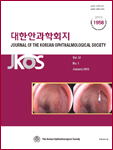
Journal of the Korean Ophthalmological Society
Cultivating Knowledge for Tomorrow's Eye CareThe Journal of the Korean Ophthalmological Society, with ISSN 0378-6471 and E-ISSN 2092-9374, is a pivotal resource in the field of ophthalmology, published by the esteemed Korean Ophthalmological Society. Based in South Korea, this journal is committed to advancing knowledge in ophthalmology through the dissemination of research that spans both clinical and experimental studies. Despite its current Q4 ranking in the 2023 Ophthalmology category, it serves as a crucial platform for emerging scholars, practitioners, and students seeking to contribute to and learn from the latest developments in eye care. While the journal does not currently offer open access, it is dedicated to fostering scientific dialogue and innovation within the community. With convergence years from 2018 to 2024, the journal's focus on contemporary issues in ophthalmology positions it as a relevant and timely source of information, critical for those engaged in this dynamic field. For further inquiries, the journal can be contacted at their address in Seoul, South Korea: SKY 1004 BLDG 701, 50-1 Jungnim-ro, Jung-gu, 04508.